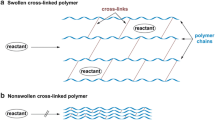Abstract
Conformationally restricted amino acids are important components in peptidomimetics and drug design. Herein, we describe the synthesis of a novel, non-proteinogenic constrained delta amino acid containing a cyclobutane ring, cis-3(aminomethyl)cyclobutane carboxylic acid (ACCA). The synthesis of the target amino acid was achieved in seven steps, with the key reaction being a base induced intramolecular nucleophilic substitution. A small library of dipeptides was prepared through the coupling of ACCA with proteinogenic amino acids.






Similar content being viewed by others
References
Aguilera J, Gutierrez-Abad R, Mor A, Moglioni AG, Moltrasio GY, Ortuno RM (2008a) Stereoselective synthesis of cyclobutyl gamma-amino acids leading to branched peptides with a cyclobutane core. Tetrahedron Asymmetry 19(24):2864–2869
Aguilera J, Moglioni AG, Moltrasio GY, Ortuno RM (2008b) Stereodivergent synthesis of the first bis(cyclobutane) γ-dipeptides and mixed γ-oligomers. Tetrahedron Asymmetry 19:302–308
Allan RD, Hanrahan JR, Hambley TW, Johnston GAR, Mewett KN, Mitrovic AD (1990) Synthesis and activity of a potent N-methyl-d-aspartic acid agonist, trans-1-aminocyclobutane-1,3-dicarboxylic acid, and related phosphonic and carboxylic acids. J Med Chem 33(10):2905–2915
Andre’ V, Vidal A, Ollivier J, Robin S, Aitken DJ (2011) Rapid access to cis-cyclobutane gamma-amino acids in enantiomerically pure form. Tetrahedron Lett 52(12):1253–1255
Basu MK, Sarkar DC, Ranu BC (1989) A mild and selective method of ester hydrolysis. Synth Commun 19:627–631
Boger DL, Labroli MA, Marsilje TH, Jin Q, Hedrick MP, Baker SJ, Shim JH, Benkovic SJ (2000) Conformationally restricted analogues designed for selective inhibition of GAR Tfase versus thymidylate synthase or dihydrofolate reductase. Bioorg Med Chem 8(5):1075–1086
Burgess K, Li S, Rebenspies J (1997) Chiral 1,3-cyclobutane amino acids: syntheses and extended conformations. Tetrahedron Lett 38(10):1681–1684
Celis S, Gorrea E, Nolis P, Illa O, Ortuno RM (2012) Designing hybrid foldamers: the effect on the peptide conformational bias of [small beta]-versus [small alpha]- and [gamma]-linear residues in alternation with (1R,2S)-2-aminocyclobutane-1-carboxylic acid. Org Biomol Chem 10(4):861–868
Cook GR, Beholz LG, Stille JR (1994) Construction of hydroxylated alkaloids (±)-mannonolactam, (±)-deoxymannojirimycin, and (±)-prosopinine through aza-annulation. J Org Chem 59(13):3575–3584
Dembitsky V (2008) Bioactive cyclobutane-containing alkaloids. J Nat Med 62(1):1–33
Fernandez F, Lopez C, Hergueta AR (1995) Synthesis of a precursor of cyclobutane carbocyclic nucleosides from alpha-pinene. Tetrahedron 51(37):10317–10322
Fernandez-Tejada A, Corzana F, Busto JH, Avenoza A, Peregrina JM (2009) Stabilizing unusual conformations in small peptides and glucopeptides using a hydroxylated cyclobutane amino acid. Org Biomol Chem 7(14):2885–2893
Galeazzi R, Mobbili G, Orena M (1999) From pyrrolidin-2-ones to 3-aza-2-oxobicyclo[3.2.0]heptanes. Synthesis of both enantiomers of cis-2-aminomethylcyclobutane carboxylic acid, a conformationally restricted analogue of GABA. Tetrahedron 55(1):261–270
Gante J (1994) Peptidomimetics—tailored enzyme-inhibitors. Angew Chem, Int Ed Engl 33(17):1699–1720
Garegg J, Samuelsson B (1980) Novel reagent system for converting a hydroxy-group into an iodo-group in carbohydrates with inversion of configuration. Part 2. J Chem Soc Perkin Trans 1:2866–2869
Giannis A, Kolter T (1993) Peptidomimetics for receptor ligands-discovery, development, and medical perspectives. Angew Chem, Int Ed Engl 32:1244–1267
Gorrea E, Nolis P, Torres E, Da Silva E, Amabilino DB, Branchadell V, Ortuño RM (2011) Self-assembly of chiral trans-cyclobutane-containing β-dipeptides into ordered aggregates. Chem—Eur J 17(16):4588–4597
Gray D, Gallagher T (2006) A flexible strategy for the synthesis of tri- and tetracyclic lupin alkaloids: synthesis of (+)-cytisine, (±)-anagyrine and (±)-thermopsine. Angew Chem, Int Ed Engl 45:2419–2423
Gutierrez-Abad R, Illa O, Ortuno RM (2010) Synthesis of chiral cyclobutane containing C3-symmetric peptide dendrimers. Org Lett 12(14):3148–3151
Gutiérrez-Abad R, Carbajo D, Nolis P, Acosta-Silva C, Cobos J, Illa O, Royo M, Ortuño R (2011) Synthesis and structural study of highly constrained hybrid cyclobutane-proline γ,γ-peptides. Amino Acids 41(3):673–686
Izquierdo S, Rua F, Sbai A, Parella T, Alvarez-Larena A, Branchadell V, Ortuno RM (2005) (+)- and (-)-2-Aminocyclobutane-1-carboxylic acids and their incorporation into highly rigid beta-peptides: stereoselective synthesis and a structural study. J Org Chem 70(20):7963–7971
Lee-Ruff E, Mladenova G (2003) Enantiomerically pure cyclobutane derivatives and their use in organic synthesis. Chem Rev 103(4):1449–1484
Miller SJ, Grubbs RH (1995) Synthesis of conformationally restricted amino acids and peptides employing olefin metathesis. J Am Chem Soc 117(21):5855–5856
Namyslo JC, Kaufmann DE (2003) The application of cyclobutane derivatives in organic synthesis. Chem Rev 103(4):1485–1538
Qureshi M, Qureshi S, Singhal SC (1968) An ion exchange method for the determination of aliphatic amides and esters. Anal Chem 40(12):1781–1783
Shang YM, Li J, Song ZG, Li YG, Huang HM (2007) Chem Res Chin Univ 23:430–432
Singh S, Duffy CD, Shah STA, Guiry PJ (2008) ZrCl4 as an efficient catalyst for a novel one-pot protection/deprotection synthetic methodology. J Org Chem 73(16):6429–6432
Smith AB, Hirschmann R, Pasternak A, Akaishi R, Guzman MC, Jones DR, Keenan TP, Sprengeler PA, Darke PL (2002) J Med Chem 37:215–218
Torres E, Gorrea E, Silva ED, Nolis P, Branchadell V, Ortuno RM (2009) Prevalence of eight-membered hydrogen-bonded rings in some bis(cyclobutane) beta-dipeptides including residues with trans stereochemistry. Org Lett 11(11):2301–2304
Acknowledgments
We would like to thank the Irish Research Council for Science, Engineering and Technology (IRCSET) for funding this research. We would also like to acknowledge the facilities of the Centre for Synthesis and Chemical Biology (CSCB), funded by the Higher Education Authority’s Programme for Research in Third-Level Institutions (PRTLIs). We are grateful to Dr. Jimmy Muldoon for his help with the NMR experiments.
Author information
Authors and Affiliations
Corresponding author
Additional information
E. O’Reilly and L. Pes contributed equally to this paper.
Electronic supplementary material
Below is the link to the electronic supplementary material.
Rights and permissions
About this article
Cite this article
O’Reilly, E., Pes, L., Ortin, Y. et al. Synthesis of a conformationally constrained δ-amino acid building block. Amino Acids 44, 511–518 (2013). https://doi.org/10.1007/s00726-012-1362-3
Received:
Accepted:
Published:
Issue Date:
DOI: https://doi.org/10.1007/s00726-012-1362-3




